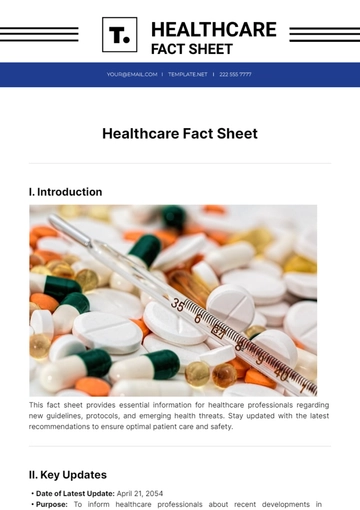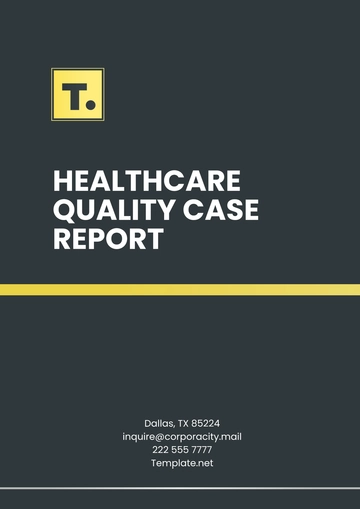Free Nursing Home Waste Management Portfolio

I. Executive Summary
At [Your Company Name], we are dedicated to leading in environmental stewardship while providing exceptional care to our residents. This Waste Management Portfolio outlines our comprehensive approach to managing waste in a responsible, efficient, and compliant manner. Our strategies aim to minimize waste, promote recycling, ensure proper disposal of hazardous materials, and maintain a safe and healthy environment for both our residents and staff. Through rigorous training, continuous improvement, and adherence to regulatory standards, [Your Company Name] commits to excellence in waste management.
II. Introduction to Waste Management in Nursing Homes
Effective waste management is crucial in nursing homes, where the health and safety of residents are of paramount importance. [Your Company Name] generates a variety of waste types, each requiring specific handling procedures to mitigate risks to health and the environment. This section categorizes waste types and highlights the importance of adhering to a robust regulatory framework designed to ensure safe waste management practices.
Types of Waste Generated
General Waste: Non-hazardous waste similar to household waste.
Medical Waste: Includes clinical waste such as syringes, bandages, and gloves.
Hazardous Waste: Chemicals, batteries, and any material that can pose a danger to health or the environment.
Pharmaceutical Waste: Expired, unused, or contaminated drugs and vaccines.
E-Waste: Electronic equipment and batteries.
Regulatory Framework
Health Insurance Portability and Accountability Act (HIPAA)
Resource Conservation and Recovery Act (RCRA)
Occupational Safety and Health Administration (OSHA) standards
State-specific healthcare waste regulations
III. Waste Management Policy
[Your Company Name]’s waste management policy is anchored in our commitment to environmental sustainability, public health, and compliance with all applicable laws and regulations. Our goals are to reduce waste generation, maximize recycling, ensure the safe disposal of hazardous materials, and foster a culture of environmental responsibility among our staff and residents.
Goals and Objectives
Reduce general waste generation by 20% within two years.
Achieve a 50% recycling rate of eligible materials annually.
Ensure 100% compliance with state and federal waste management regulations.
Implement ongoing training programs for staff on waste management best practices.
Roles and Responsibilities
Role | Responsibilities |
|---|---|
Waste Management Officer | Oversee waste management programs, ensure compliance, and liaise with disposal contractors. |
Nursing Staff | Segregate waste at the source, ensure proper disposal, and participate in training programs. |
Maintenance Staff | Handle collection and storage of segregated waste, and manage the internal logistics of waste disposal. |
Administration | Provide resources for waste management initiatives and ensure regulatory compliance. |
IV. Waste Identification and Segregation

Effective segregation of waste is critical to its proper management. [Your Company Name] utilizes a color-coded bin system to ensure the correct segregation of waste at the point of generation. This system not only facilitates recycling and safe disposal but also helps in minimizing the risks associated with hazardous waste.
Classification and Segregation Methods
Waste Type | Color Code | Disposal Method |
|---|---|---|
General Waste | BLACK | Municipal waste collection |
Medical Waste | YELLOW | Incineration or specialized medical waste disposal |
Hazardous Waste | RED | Hazardous waste treatment facility |
Pharmaceutical Waste | BLUE | Return to pharmacy or hazardous waste facility |
E-Waste | GREEN | E-waste recycling center |
Handling and Storage Protocols
General Waste: Securely bagged and stored in covered bins. Emptied daily.
Medical Waste: Stored in puncture-proof containers, labeled, and kept in designated secure areas. Disposed of through licensed medical waste carriers.
Hazardous Waste: Stored in compatible containers with clear labeling and hazard symbols. Disposal is conducted by certified hazardous waste disposal services.
Pharmaceutical Waste: Segregated into non-hazardous and hazardous pharmaceutical waste. Stored according to the risk category and disposed of in compliance with federal regulations.
E-Waste: Collected in designated bins and stored in a dry, secure area until pickup by a certified e-waste recycling service.
V. Waste Minimization and Recycling Programs
[Your Company Name] is committed to reducing the waste generated by our operations and maximizing the materials we recycle. Our approach not only benefits the environment but also aligns with our sustainability goals.
Strategies for Waste Reduction
Audit and Monitoring: Regular waste audits to identify reduction opportunities.
Procurement Policies: Purchasing products with minimal packaging and preferring reusable products.
Food Waste Management: Implementing composting and food donation programs.
Recycling Programs
Single-Stream Recycling: Encouraging the use of single-stream recycling bins for paper, plastic, and metals.
Specialty Recycling: Programs for batteries, electronics, and light bulbs.
Partnering with Local Recyclers: Establishing partnerships with recycling facilities and exploring innovative recycling solutions.
VI. Medical Waste Management
Effective management of medical waste is critical to prevent the spread of infections and ensure the safety of both residents and staff. [Your Company Name] employs a multi-faceted approach to handle, treat, and dispose of medical waste responsibly.
Special Considerations for Medical Waste:
Sharps Disposal: All sharps are immediately placed in FDA-approved containers that are puncture-resistant, leak-proof, and labeled or color-coded. Containers are located in areas where sharps are commonly used, minimizing the risk of needle-stick injuries.
Pharmaceutical Waste: Pharmaceuticals are categorized into non-hazardous and hazardous waste. Non-hazardous drugs are disposed of in blue containers, while hazardous drugs, including chemotherapy agents, are disposed of in containers designated for hazardous waste.
Clinical Waste: Includes items contaminated with bodily fluids and laboratory waste. Such waste is bagged in yellow, leak-proof clinical waste bags and stored in a secure location until incinerated.
Disposal Methods and Contractor Details

Incineration: Preferred method for most medical waste, ensuring complete destruction of pathogens.
Autoclaving: Used for non-hazardous medical waste, rendering it non-infectious before disposal.
Contracted Services: [Your Company Name] partners with licensed medical waste disposal firms that comply with local, state, and federal regulations, ensuring safe and ethical disposal.
VII. Training and Education
Ongoing education and training are cornerstones of [Your Company Name]'s waste management program, ensuring all team members are equipped with the latest knowledge and best practices.
Training Program Details
Initial Training for New Employees: Covers basic waste segregation, handling protocols, and personal protective equipment (PPE) requirements.
Annual Refresher Courses: Mandatory for all staff, focusing on updates in waste management regulations, new procedures, and review of company policies.
Specialized Training for Handling Hazardous Waste: Targeted training for maintenance and janitorial staff, focusing on the risks associated with hazardous waste and emergency response procedures.
Educational Materials and Evaluation
Educational Materials | Evaluation and Certification |
Includes detailed manuals, online training modules, and quick-reference guides available in all service areas. | Post-training assessments to ensure comprehension and competency. Certification is required for staff involved in the handling and disposal of hazardous and medical waste. |
VIII. Waste Collection and Disposal
Ensuring timely collection and proper disposal of waste is essential for maintaining hygiene and safety standards at [Your Company Name].
Collection Schedule and Procedures
Daily Collection | Scheduled Collection for Hazardous and Medical Waste | Secure Storage |
For general and food waste, ensure that waste does not accumulate and pose health risks. | Coordinated with licensed disposal companies, adhering to strict guidelines to prevent exposure and contamination. | Waste awaiting collection is stored in designated, secure areas, away from resident zones to minimize risk. |
Compliance and Documentation
It is compulsory for compliance and auditing purposes to consistently manage and keep detailed records relating to the generation, collection, and disposal of waste. Such records should comprehensively cover different aspects including the manifests received from haulers specialized in handling hazardous waste. Additionally, the logs detailing the quantities and various types of waste that have been managed should also be included in the said records.
IX. Emergency Preparedness and Response
[Your Company Name] is fully prepared to respond to any waste management emergency, from spillage of hazardous materials to exposure incidents.
Detailed Response Plans
Spill Response Plan: Includes immediate containment and cleanup procedures, PPE requirements, and notification protocols.
Exposure Response Plan: Steps to be taken in the event of exposure to hazardous waste, including medical treatment and incident reporting.
Training and Drills
There are regular training sessions being conducted which focus mainly on the procedures for the emergency response. To ensure readiness for any situation and to have a strong familiarity with the response protocols, these sessions are also complemented by various drills.
X. Monitoring, Auditing, and Reporting
Continuous improvement in waste management practices is achieved through diligent monitoring, thorough auditing, and transparent reporting.
Monitoring and Auditing
Regular Inspections: Routine inspections of waste storage areas and review of waste management practices to identify areas for improvement.
External Audits: Annual audits conducted by third-party environmental consultants to assess compliance with regulations and the effectiveness of waste management strategies.
Reporting Mechanisms
Internal Reporting: Monthly reports on waste generation and diversion rates, reviewed by management to track progress towards waste reduction goals.
External Reporting: Annual sustainability reports shared with stakeholders, detailing achievements in waste management and environmental stewardship.
XI. Continuous Improvement and Innovation
At [Your Company Name], we recognize that the landscape of waste management is constantly evolving, driven by technological advances, regulatory changes, and our increasing understanding of environmental impacts. Therefore, we are committed to a philosophy of continuous improvement and innovation in our waste management practices. This commitment is manifested through regular review and enhancement of our policies, procedures, and technologies related to waste management.
Annually, we undertake a comprehensive review of our waste management program to identify areas for improvement, efficiency gains, and opportunities to reduce our environmental footprint. This process involves soliciting feedback from staff across all levels of our organization, reviewing incident reports, and analyzing the latest developments in waste management technologies and practices. Through this review, we aim to identify practical innovations that can be implemented within our facilities, such as the adoption of more sustainable materials, the introduction of advanced waste treatment technologies, or the enhancement of our recycling programs.
Innovation is not just about adopting new technologies but also about fostering a culture that encourages creativity and problem-solving among our staff. To this end, [Your Company Name] actively encourages staff to come forward with ideas that can lead to better waste management outcomes. We facilitate this through regular innovation workshops and suggestion schemes, where staff can propose ideas, which are then evaluated for feasibility and potential impact.
Furthermore, we engage with external experts, including environmental consultants, waste management professionals, and regulatory bodies, to gain insights into best practices and emerging trends in waste management. This external engagement ensures that our waste management strategies are not only compliant with current regulations but are also aligned with the best practices and innovations in the field.
To track the effectiveness of our continuous improvement efforts, we establish clear metrics and benchmarks related to waste reduction, recycling rates, and compliance. These metrics are regularly monitored and reported to senior management, ensuring that waste management remains a key focus area for our organization.
XII. Conclusion
At [Your Company Name], we recognize the importance of effective waste management in maintaining a safe, healthy, and sustainable environment for our residents and staff. This Waste Management Portfolio reflects our commitment to environmental stewardship and our continuous effort to improve our waste management practices. We pledge to remain vigilant, adaptive, and innovative in our approach, ensuring compliance with regulations and fostering a culture of sustainability within our community.
- 100% Customizable, free editor
- Access 1 Million+ Templates, photo’s & graphics
- Download or share as a template
- Click and replace photos, graphics, text, backgrounds
- Resize, crop, AI write & more
- Access advanced editor
Enhance sustainability with Template.net's Nursing Home Waste Management Portfolio Template. Designed for efficient waste reduction and management, this template is fully customizable and editable through our Ai Editor Tool. Implement eco-friendly practices, ensuring environmental responsibility and compliance. An essential tool for promoting green initiatives in nursing homes, exclusively available at Template.net.





























